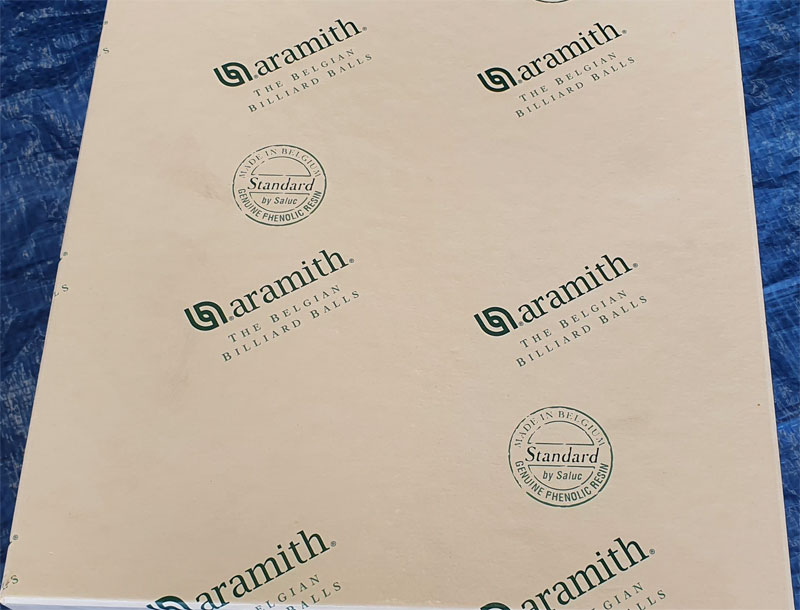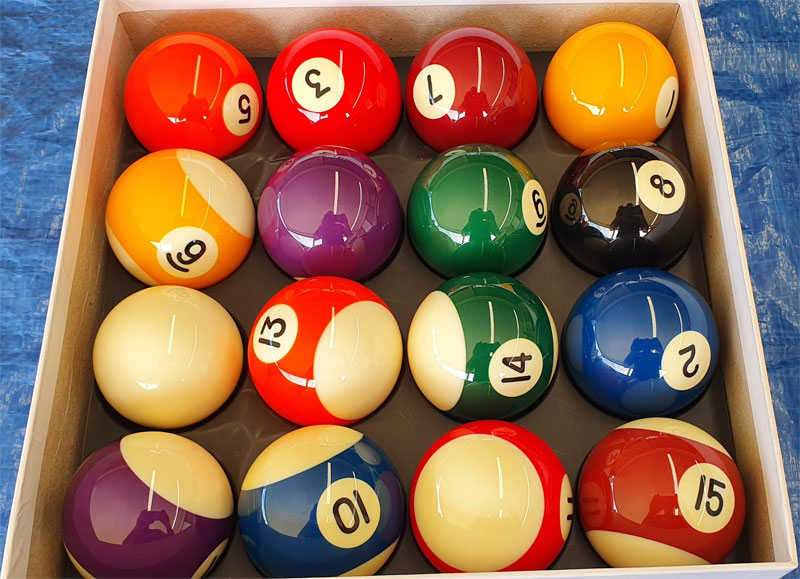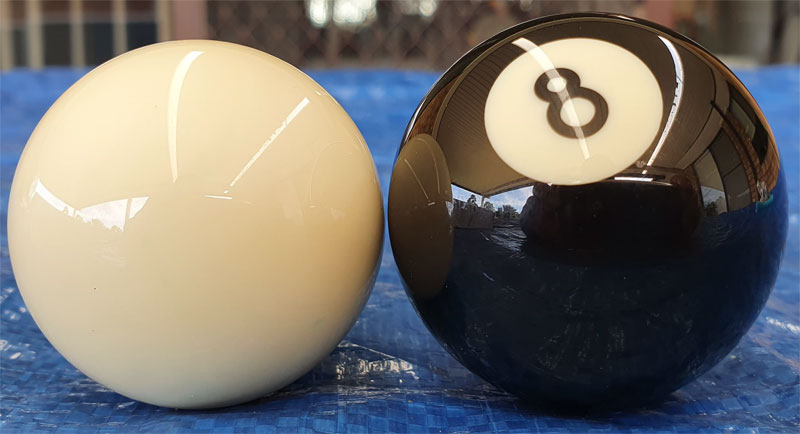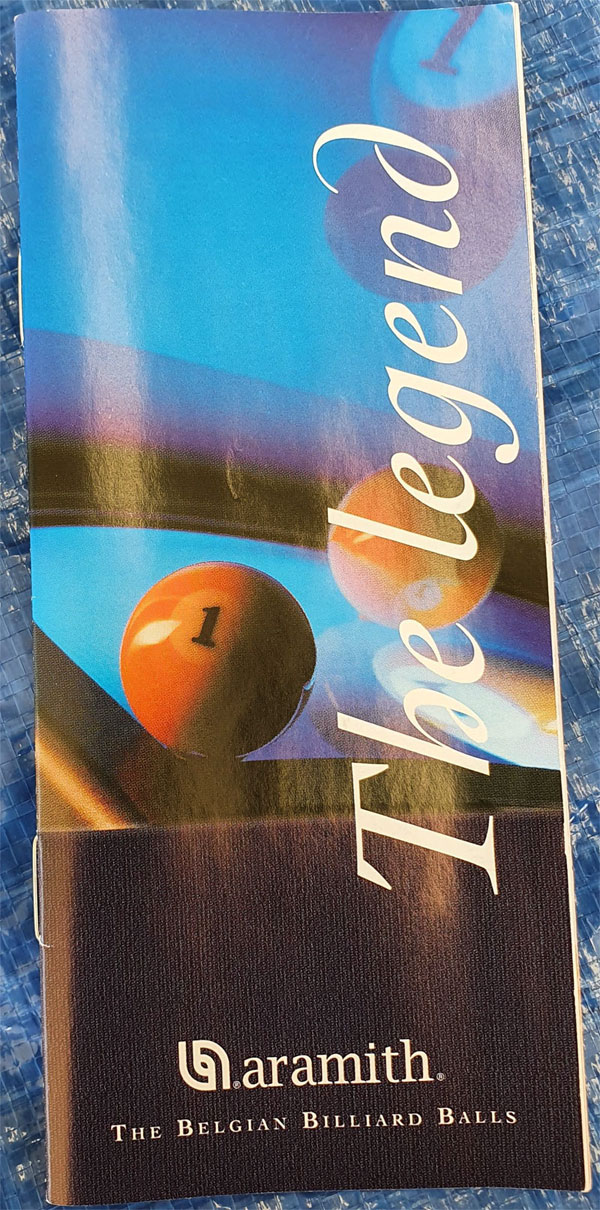Aramith Belgian Balls
1/15/2021 1:58:07 PM
Aramith Belgian Balls
I recently picked up a set of 2-inch standard Belgian Aramith balls. They are beautiful and play like an absolute dream on my pool table but I have a couple of questions about them.
- Ball sizes - I noticed the numbered balls are 2 inches in diameter, but the cue ball is 1 7/8th inches. Why is the cue ball a size down from the numbered balls? Is this part of Aramith's precision design?
- Colors - The 7 and 15 balls are two different colors. The 7 is a maroon color but the 15 is actually a brown color. Is that normal for Aramith balls?
Aramith Belgian Balls
Replies & Comments
 RayMills on 1/16/2021 6:19:05 PM
RayMills on 1/16/2021 6:19:05 PMIf 2" is standard to you, you might want to tell us where you are in the world and what versions of billiards you are playing (standard for USA is 2.25").
If you "picked up" the balls, does that mean that they were previously owned, and more likely to have been mixed with other ball sets? For example, that is a very small cue ball, and anything smaller than the balls into which it's being driven would cause them to hop off the pool table's surface most of the time.
None of this sounds "Aramith normal".
Eric4690 on 1/16/2021 6:21:01 PM
I bought the set brand new. The balls weren't mixed up at all.
I live in Australia, by the way.
 RayMills on 1/16/2021 8:25:08 PM
RayMills on 1/16/2021 8:25:08 PMI searched for "Australian pool balls" and, surprisingly, received only one hit:
cuesports.com.au/balls
There was one listing of balls, called English 8-Ball, which listed your sizes. I am totally surprised that a set would include a small cue ball, which I believe is also lighter than the others. I'm assuming this oddity is not to facilitate a coin-op separator, unless it a holdover from when it was needed before the magnet systems were invented.
Also, maybe having a lighter weight somehow compensates for the smaller ball and reduces the table hopping I mentioned.
I think if your 7 doesn't match your 15 you should go get an exchange.
 billiardsforum on 1/17/2021 3:06:34 PM
billiardsforum on 1/17/2021 3:06:34 PM@Eric4690 - Two things:
- Can you post a photo of the box, and another including the barcode and/or any writing that might be on the box itself? Also post a picture of any papers included in the box.
- Can you share where you bought them? If online, please let us know the URL to the product listing.
Aramith has produced a gazillion different ball sets over the years. Different ball sets may have different dimensions, depending on their intended use .
At this point, I assume you have the actual box and receipt, etc. but we're stuck here guessing at what you might have bought.
Help us help you!
 RayMills on 1/19/2021 3:30:55 AM
RayMills on 1/19/2021 3:30:55 AMAfter much research, including emailing the site referenced above, it appears that a smaller cue ball is normal in and around Australia. A history of having cue balls sorted by their smaller size on coin-ops in pubs has established that even tournaments are played on coin-ops even when the tables are set to free play.
I found an article from a shop west of London. I don't know whether the smaller cue balls are as prevalent in Australia as they are in England.
Ball Styles Compared
- American Pool Balls
- Cue Ball: 2 ¼ inches. 169g
- Object Ball: 2 ¼ inches. 169g
- English Pool Balls
- Cue Ball: 1 1/17 inches. 96g
- Object Ball: 2 inches. 118g
American pool balls are instantly recognizable and the simplest sets to explain. They’re large, 2 ¼ inch balls finished with the iconic spots and stripes, with the cue ball matching the object ball in both size and weight.
English pool balls on the other hand are a little more unique. For a start, the cue ball is marginally smaller than the object balls, being only 1 1/17 inches as opposed to 2 inches. The reason for this difference isn’t anything majorly important. It is mainly to allow coin operated tables to separate the cue ball from the rest of the object balls. Despite many tournaments not using coin operated tables, the sizes of these balls are also used in English pool tournaments.
Whilst the two types of balls are obviously different in size, the most stark between them is the difference in cue ball size and weight. An English cue ball weighs only 57% of the weight of an American cue ball, meaning the two games will feel rather different as a result. It’s for this very reason too that different types of cue are used for the different games (which we will cover in a later
Source: homeleisuredirect.com/pool_tables/buying-advice/what-are-the-differences-between-english-and-american-pool.html
I'll leave it to the forum's physics experts to tell us how much of small ball's forward energy is transferred to upward motion when the height deficit is 0.125 inch into a 2" ball and the weight deficit is 96g into 118g. I wonder if jump shots are more difficult or easy Down Under: ooo, that's a double entendre!
- American Pool Balls
 RayMills on 1/20/2021 1:11:58 AM
RayMills on 1/20/2021 1:11:58 AMAgain, the "cuesports" link listed above was correct only in that it showed where the only search hit went.
@billiardsforum has reproduced the correct article and site, which the source site still posts with erroneous data: I'm assuming "1 1/17 inches" and "1 ?" small cue ball measurements should instead be 1 7/8 inches.
It surprised me to read that this English cue ball is 57% the weight of an American 2 1/4" ball, but they wouldn't be used together anyway, right? How much hopping would THAT produce?
Dr. Dave suggests we view his video about smaller balls, but the vertical effect issue appears to be more trivial than the effect on cut angles.
Eric4690 on 2/4/2021 10:10:08 PM
Thanks so much for the info. Sorry I've been away from the thread for so long.
Here are some photos of my Aramith ball set.
I included a shot of the cue ball and the 8 so you can clearly see the size difference.
Let me know what you all think.
Thanks.
 RayMills on 2/5/2021 4:49:39 PM
RayMills on 2/5/2021 4:49:39 PMWell, as you can tell, the small cue ball difference really bothered me until the last post. It would still bother me if I knew I was mixing balls in my game, but that's from growing up with uniform sets. (Listen to me, like I'm ever going to be good enough to know the difference!)
From this point forward the biggest questions are where you're going to use the balls, on what size table(s), and with which other players?
At home, you can decide your own billiards future, including whether you'll be taking them with you if you ever compete elsewhere, and whether alternating cue balls is helpful to you.
If 2" balls and a smaller cue ball is the overriding Australian custom, you'll probably stick with that. By the way, what is your table's size and the usual overall size of Aussie tables? I doubt that pockets vary much across the country.
If you use different size balls than those to which your opponents are accustomed, you'll get major grief; no home-field advantage! For solo practice, USA balls might up your game just as smaller pockets would.
I can't tell any difference in the ball colors. There's a slight chance Aramith manufactures a slightly different set of colors for the solids because they sometimes cater to the 9-Ball game, but that shouldn't have applied to your set. You'll always be bothered by noticing the variance.
I think you should ask Aramith (or your generous retailer) for a replacement, and try to get a 2" measle cue ball for your trouble....
Eric4690 on 2/5/2021 5:05:10 PM
Hi Ray, thanks for your reply.
My pool table is only a 7-foot table. Not a big one by any means.
6 ft and 7 ft is considered standard for a "pub size" pool table over here in Australia. Anything above that is basically considered snooker size. I believe over there in the US, 8 foot tables are considered "professional" size.
I chose the 2 inch balls according to a chart I was looking at on Wikipedia because it said 1 7/8 inch and 2 inch balls are ideal for that size pool table. 8 foot pool tables and upwards all seem to recommend 2 1/4".
I'm no expert on these things but I'm very relieved that the small cue ball is a normal aspect for us over here. As stated previously Aramith have come out with countless sets over the years and being the tournament standard they would cater for the American and English game. After all English tables do play different from American tables. English tables tend to have the tighter pockets which is what my table has.
As far as the 7-ball and 15-ball being slightly different shades—it could be that they're aiming for an American-style set because I have seen (in modern 9 ball tournaments) that there is a brown ball in American sets. To be honest I don't even really notice the difference in color anymore. I have also half thought of getting a 2 inch measle ball for this set so I can have the same size cue ball. I'm looking into that now as a matter of fact. LOL.
As far as table hopping is concerned, I don't play with a very aggressive attack so table hopping isn't much of an issue for me. Even when I break. I find power-breaking with a lot of force results in a terrible break but more subtlety with my drive gives me a far better break. Taking my time and not slamming the balls as hard as I can like an idiot has improved my accuracy dramatically. So yeah, table hopping is extremely rare for me.
Aramith Belgian Balls
- Title: Aramith Belgian Balls
- Author: Eric4690
- Published: 1/15/2021 1:58:07 PM
- Last Updated: 1/17/2021 2:58:54 PM
- Last Updated By: billiardsforum (Billiards Forum)




